Nanotechnologies in Construction: A Scientific Internet-Journal @nanobuild-en
Статьи журнала - Nanotechnologies in Construction: A Scientific Internet-Journal
Все статьи: 572
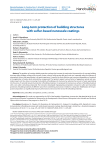
Long-term protection of building structures with sulfur-based nanoscale coatings
Статья научная
The problem of creating reliable protective coatings that increase the mechanical characteristics of concrete building structures (piles, bridges, ceiling arches, tunnels, chutes, culverts, wells, paving slabs and curbs, etc.) operated under the influence of atmospheric factors and groundwater is of great importance. Currently, the most effective way to prevent degradation of materials is the application of various kinds of protective compounds. That protects against various factors of aggressive natural and manmade impact and thus allows increasing the durability of buildings and structures by reducing the amount of water penetrating into the pores. To provide long-term protection of building materials, it is proposed to treat porous surfaces of building materials with a new sulfur-containing compound. The innovative developed impregnating composition is based on sulfur and it provides protection of building materials of different nature from weathering and corrosive media for a long time. Modification of the proposed composition can significantly improve performance and increase the service life of building materials.
Бесплатно
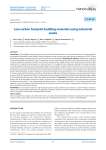
Low carbon footprint building materials using industrial waste
Статья научная
Introduction. The possibility of producing construction materials in Vietnam based on man-made waste with a low carbon footprint and capable of absorbing carbon dioxide is being considered in order to achieve zero greenhouse gas emissions by 2050. To date, insufficient attention has been paid to the search for a solution to this problem. Methods and materials. Studies were conducted to assess the possibility of obtaining a ”green“ cement-free concrete material using local industrial and agricultural waste in the form of fly ash and bottom slag from the Green Star incineration plant, alumina sludge, ceramic waste, lime powder and coconut fiber combined with a special activating agent. an alkaline solution. The average density, compressive strength, and water absorption of the developed cement-free concrete were determined on cube samples measuring 100×100×100 mm in accordance with the requirements of current Vietnamese standards. The ability of the resulting concrete to absorb carbon dioxide was evaluated using the developed method by measuring the mass of carbon dioxide absorbed by concrete samples. Results and discussion. The average density of the developed concrete is 1950 kg/m3; compressive strength at the age of 28 days is 7.5–11.5 MPa; water absorption is 8–10% by weight. The main advantages of using cement-free concrete of the developed composition include reducing the carbon footprint due to the abandonment of the use of Portland cement, the ability of concrete to absorb carbon dioxide and the possibility of recycling high-tonnage man-made waste during its manufacture. Conclusion. The results of the conducted research show that the use of the developed cement-free ”green“ concrete for the manufacture of building products and structures in Vietnam will allow to recycle about 1.1 tons. high-tonnage industrial waste per 1 cubic meter and absorb 10–13 kg of carbon dioxide during operation. This will contribute to the implementation of the planned course for the ”green“ transformation of Vietnam's economy into a sustainable closed-loop economy.
Бесплатно
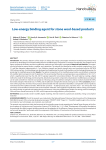
Low-energy binding agent for stone wool-based products
Статья научная
Introduction. The primary objective of this study is to reduce the energy consumption involved in manufacturing mineral wool products by developing an innovative binder based on modified epoxy compounds. To achieve this objective, the potential use of epoxy compounds as binders and their modification methods were thoroughly investigated. Materials and Methods. The materials used included an epoxy binder, a modifier, and a plasticizer. The mineral wool featured an acidity modulus ranging from 1.8 to 2.1 and fiber diameters approximately 4–5 μm. Adhesion strength and tensile strength tests were conducted using an INSTRON 3382 testing machine. A methodology was developed and implemented to study the formulation and technological parameters for producing the modified epoxy binder. Results. The optimal composition of the modified epoxy binder was identified, comprising 6% modifier (latent component) and 3% plasticizer. The recommended thermal curing temperature was established at 150–154 °C, which is significantly lower than the 240–320 °C typically required for conventional binders. This work helps by creating a digital method to study the technology and showing that, obtained using a latent component and plasticizer, modified epoxy compounds can be used as binders for mineral wool products. Following curing, the adhesion strength to mineral surfaces reached 58.4 MPa, the tensile strength of the binder was 77.4 MPa, and the adhesion strength after climatic testing was 29.1 MPa. Conclusion. Assessment of the properties of mineral wool products demonstrated that their operational durability is comparable to that of products manufactured with traditional binders. Mineral fiber products – including basalt, glass, and stone wool – are among the most commonly used and effective thermal and sound insulation materials. Their application significantly reduces energy consumption for cooling during hot periods and heating during cold seasons. Using the modified epoxy binder cuts energy costs for heating by 50% and lowers overall heat use by 20–30%, which improves the energy efficiency of the products.
Бесплатно
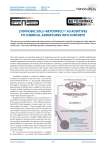
Lyophobic sols «БЕТОПРЕСС»® as additives to chemical admixtures into concrete
Статья научная
The article presents an innovative approach to enhancing cement concrete, bordering on a scientific breakthrough, and explains it in a way that is easy to understand. The core concept is the integration of a reactive agent with a chemical fluid to augment the material and endow it with novel characteristics. The technique, as suggested by the author, involves utilizing lyophobic sols that they have formulated as admixtures, combined with aqueous solutions of chemical additives produced by Russian companies. Due to the inclusion of these Nanostructured sols in the chemical additives, heavy cement concrete treated in this manner shows remarkable resilience. It remains unaffected by repeated freeze-thaw cycles, even when immersed in saline or mineral-rich waters. Furthermore, this advanced concrete does not demand any special measures for protection, maintenance, or repair, nor does it require additional waterproofing.
Бесплатно
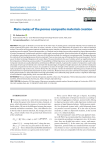
Main routes of the porous composite materials creation
Статья научная
This paper is devoted to an overview of the main ways of creating porous composite materials. Porous materials are solids containing free space in the form of cavities, channels, or pores, which determine the presence of an internal interfacial surface. The analysis of the general methods of obtaining porous materials. A deposition is one of the most common methods for producing porous materials. Thermal decomposition, as a method used to obtain porous oxide materials by thermal decomposition of various compounds. Hydrothermal synthesis is widely used to produce zeolites. Selective dissolution of individual components of a substance using chemical reactions is also one of the effective methods for creating or increasing porosity. The paper discusses the methods of forming highly porous refractory materials. There are two main ways of forming refractory ceramic products. The first way is the direct sintering of dispersions of ceramic fibers. The second method is the use of a binder, which can significantly reduce the temperature of obtaining a porous product. The possibilities of obtaining porous nanocomposites based on aerogels are shown. Composite materials are usually obtained by combining two different materials. In general, the creation of composites is used to take advantage of each type of material and to minimize their disadvantages. Aerogels are fragile substances. But with the introduction of another component into their structure, it is possible to increase the strength of the material. Such materials have the desired optical properties, high surface area, and low density like silica aerogel. A review of methods for obtaining porous materials using the phenomenon of spinodal decomposition has been carried out. Materials whose structure is formed in microphase separation during polymerization or polycondensation have high permeability and a sufficiently large specific surface. A significant advantage of such materials is high porosity, which can reach 80% or more.
Бесплатно
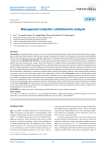
Management Analytics: A Bibliometric Analysis
Статья научная
Introduction. As nanotechnology continues to evolve and its industrial applications expand, the need for effective data management, analysis, and dissemination is becoming more urgent. Management analytics has emerged as a critical new interdisciplinary field in current business environments, enabling organizations to leverage data-driven insights for informed decision-making and strategic planning. Methods and materials. This study reviews and analyzes research in the interdisciplinary field of management analytics for the period from 2021 to 2023. To conduct bibliometric analysis, data from various sources were used, including academic publications, monographs, reviews, reports, etc. Through a systematic review of the relevant literature, this study aims to provide insight into key topics, methodologies and outcomes in the field of management analytics, as well as to identify directions for future research directions. Results: according to the results of the analysis, it was found that the main source of articles in this area is the Journal of Management Analytics. The total number of publications on this topic for the period amounted to 83 units, the total number of citations for a certain time period has been increasing. The leading countries in terms of the number of citations of academic articles on the topic under study are the United States, India and China. Discussion. So far, the interdisciplinary field of management analytics has not been widely discussed in academic circles. However, leading countries in the world in terms of the number of academic articles and citations are at the forefront of this emerging field. This should be taken into account especially in the development of the nanosystems and nanomaterials industry, which is one of the priority areas for the development of science and technology, where management analytics technologies will be in demand and can provide competitive advantages to companies. Conclusion. The importance of the new interdisciplinary field of management analytics will continue to grow. In the course of the study, it was found that this emerging field has been increasing its popularity and it could be an effective tool for organizations in the nearest fu-ture.
Бесплатно

Статья научная
Introduction. Existing automated construction inspection technologies do not allow the user to select the level of detail. At the same time, in the context of the use of nanotechnology, there is a growing need to expand the capabilities of monitoring and control of construction projects. The aim of the research is to develop, implement software, and validate a technology for controlling the speed and accuracy of constructing three-dimensional models from dense point clouds for automated monitoring of construction works. Materials and methods. The research is based on the methodology of non-binary data trees, including the method of constructing octant trees. An unmanned aerial vehicle with an aerial laser scanner, a ground-based scanning total station, and specialized software were used, including the web application “Management System for Monitoring Construction Works on Objects that have undergone state expertise” developed with the participation of the authors. Results and discussion. In the course of the study, a technology was developed and implemented in software that allows the user to select the required balance between accuracy, degree of detail of monitoring and control data for construction work and time costs and computing power requirements. The comparison is made between a construction project, presented in the form of a building information model, and a three-dimensional model of a real object, obtained from a dense point cloud. The degree of comparison accuracy is set by choosing the level of octrees used. By default, the web application uses level eight. However, in the early stages of construction, when the geometric parameters of a dense point cloud deviate significantly from the design boundaries, the ninth, tenth and other levels can be used. In this case, the accuracy and degree of detail increases. Positive and negative deviations are visualized in red and blue colors, respectively, which allows the user to monitor and control the progress of work at the site. Conclusions. The developed technology can be used by customers and other decision makers to control and monitor work.
Бесплатно
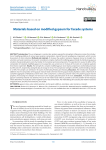
Materials based on modified gypsum for facade systems
Статья научная
Introduction. The use of gypsum in construction systems exposed to atmospheric influences involves the introduction of modifying additives of various types: polymer compositions, mineral fine and nanodisperse components, which can also be products of other industries. Methods and materials. To increase the weather resistance of gypsum stone, its strength characteristics and water resistance, the research considered a complex method of modifying gypsum binder by introducing aqueous solutions of polycondensation resins that harden in the material and nanocomponents. The experiment to assess the effect of the composition of complexly modified gypsum on its properties was carried out on the basis of the matrix of a complete quadratic three-factor experiment. Results. The strength of a complex modified gypsum stone during compression and bending increases by 30% and 25%, respectively, during 80 days of storage in the air. The compressive strength is 60 MPa, and the bending strength is 12 MPa. The samples can withstand 150 cycles of alternating freezing and thawing. Discussion. The introduction of polymer additives into the composition of the gypsum mixture leads to the fact that the gypsum during hydration creates a framework of crystalline aggregates of dehydrate, and the resin, when cured, forms a continuous polymer matrix. The polymer gypsum has the property of increasing the strength over time due to the ongoing polymerization of the resin. Conclusion. A weather-resistant gypsum-containing material was obtained. The use of man-made waste makes it possible to solve the problem of their disposal, which determines the reduction of the negative load on the environment. The methodology for assessing the weather resistance of gypsum stone, and, first, frost resistance, was tested.
Бесплатно
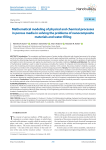
Статья научная
Introduction. The complexity and laboriousness of system studies of physical and chemical processes in the volume and at the interface of the porous medium determines the need to apply mathematical modeling. This allows not only to identify and study the determining physical and chemical processes in a porous medium, but also to solve the problems of optimization and optimal control of processes and regimes by selecting the most favorable conditions. Methods and Materials. The method of mathematical modeling is used to study the processes, including the creation of composite and nanocomposite materials, as well as the moistening and moisture absorption in porous materials. In this context, the porous material is treated as a pseudohomogeneous medium with averaged physical and technological parameters. Results. The mathematical models of physical and chemical processes in the porous medium have been developed, the boundary conditions have been formulated, physical and effective constants have been determined. The processes in porous medium during metallization of carbon-graphite fibrous material, moistening of compacted textile material by an air flow, and moisture absorption by porous construction materials have been studied. Discussion. The adequacy of mathematical models to real physical and chemical processes is discussed. The results of calculations obtained by modeling equations implemented in the form of computer computational algorithms and experiments are compared. Conclusions. The effectiveness of the method for studying physical-chemical processes in a porous medium and for calculating optimal values of technological parameters has been established. ACKNOWLEDGEMENTS. The research was carried out with the financial support of Moscow State University of Civil Engineering. (Contract No. PSUAC/K-23 dated 05.06.2023) within the 2023 competition for basic and applied research (R&D) by scientific teams of organizations – members and strategic partners of the Industry Consortium “Construction and Architecture” in order to implement the Development Program of Moscow State University of Civil Engineering and Architecture for 2021–2030 as part of the Strategic Academic Leadership the “Priority-2030”.
Бесплатно
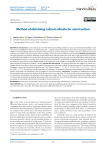
Method of obtaining calcium silicate for construction
Статья научная
Introduction. Calcium silicate is one of the well-known building materials. Its structure determines the ability of such nanostructured additives to form a secondary structure – a fractal (volumetrical) network with which cement grains interact. The addition of nanomodifying additives to improve the technology of cement production will reduce the space dimension in which molecules are sorbed on the cement grain, and, accordingly, increase the rate and efficiency of its blocking. Methods and materials. The paper proposes a method for obtaining calcium silicate from soda ash production waste. The sol-gel method for the synthesis of individual nanomodifiers in the silicate form will improve the technology for producing concretes by forming a solid phase state of the modified structure of a cement stone. In the production of soda ash, the land plots (sludge accumulators) are allocated for the collection of production waste (distiller liquid). In this regard, the acute problem is a disposition of industry waste, because the area allocated for sludge accumulators is limited. Results and discussions. The study revealed that the addition of certain components allows us not only to reduce the required firing temperature, but also to affect the nanostructure of the resulting product. The range of values of the content of additives per 5 g of calcium silicate: С – 0.2÷0.4; S – 0.3÷0.5; ZnO – 0.1÷0.3; P2O5 – 0.3÷0.5; NH2CONH2 – 0.3÷0.3. According to the obtained matrix of conditions, 16 samples of substances were prepared. Nanomodification of cement stone leads to its hardening in the early stages of structure formation. Conclusion. The addition of hydroperite to calcium silicate significantly increases the hardness of the final product; when coal, sulfur, zinc oxide and phosphorus pentoxide are added as components, the hardness and structure of the compound changes. Thus, the use of a nanostructured cement additive based on calcium silicate obtained by qualified processing of the main waste that is part of the distiller liquid - calcium oxide, will improve the quality of concrete by improving the technology of cement production
Бесплатно
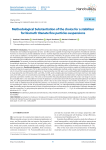
Статья научная
Introduction. The current stage of the construction industry and building materials science development involves the introduction and widespread application of nano- and fine particles capable of improving the properties of traditional materials. However, it is necessary to provide stabilization of nano- and fine-dispersed components in the cement system. Plasticizing additives can be used as stabilizers. It is important to set their concentration. Therefore, the purpose of this study is outlined, which lays in the methodological substantiation the stabilizing effect of various types of plasticizers on the suspension of fine synthetic bismuth titanate used in the modification of cement systems, and the establishment of the limits of their optimal concentrations. Materials and methods. The research is aimed at establishing the limits of optimal concentrations of polycarboxylate and sulfonaphthalene formaldehyde plasticizers. The limits of plasticizers optimal concentrationsis determined withdye solubilization method, surface tension and conductometric methods, and studies on establishing the stabilizing effect of plasticizers on a bismuth titanate fine particles suspension. Results and discussion. To establish the limits of the optimal concentration capable of stabilizing fine particles of bismuth titanate in suspension, CMC is determined by the dye solubilization method, surface tension and conductometric methods. It is found that a polycarboxylate plasticizer is characterized by one CMC point, and a sulfonaphthalinformaldehyde plasticizer is characterized by two CMC points: CMC1 and CMC2. At CMC1 point unstable spherical micelles are formed, which turn into stable ones at the CMC2 point. At concentrations exceeding the CMC2 value, polymorphic transformations of spherical micelles into nonspherical asymmetric micelles occur. The same can be traced for the polycarboxylate plasticizer CMC only in one stage. It can also be concluded that it is not reasonable to increase the plasticizer concentration above CMC for polycarboxylate plasticizer and above CMC2 for sulfonaphthalinformaldehyde plasticizer, which is due to structural changes in the micelles of plasticizers. It is assumed that in order to stabilize bismuth titanate fine particles, it is necessary to choose the plasticizers concentration within the limits not exceeding the values of CMC for polycarboxylate plasticizer and CMC2 for sulfonaphthalinformaldehyde plasticizer. Conclusion. Concluding results demonstrate the limits of optimal plasticizers concentrations for the stabilization of bismuth titanate fine particles suspension. For polycarboxylate plasticizer this range of concentrations is 1.1 – 1.5 g/l; for sulfonaphthalinformaldehyde plasticizer its 2.2 – 4.0 g/l.
Бесплатно
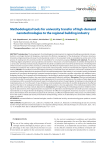
Статья научная
Introduction. The development of methodological monitoring tools to implement building nanomaterials into production is an integral element of designing a mechanism for effective management of the development of business structures. University entrepreneurship and research and educational centers in the ecosystem trend are considered as central actors in the process of creating tools for university transfer of nanobinders for construction purposes. Methods and materials. The process of forming digital competencies among students and teachers in the process of commercialization of scientific developments of a construction university (institute, faculty, department) should be considered as the result of fractal interactions. The development of the innovative ecosystem of the university is achieved by the effective implementation of the process of transferring the results of intellectual activity for the creation of gypsum and ceramic nanocomposites, which are in demand by the regional construction industry. Results. The intellectual and technological potential of universities that train bachelor’s and master’s students for the construction industry determines the prospects for the successful development of the industry in an innovative society. Accelerated promotion of investment developments, requested nanotechnologies of universities, provides universities with additional extrabudgetary funding. On the example of the development of technology for producing small-piece wall and partition products based on nanostructured gypsum binders, they were tested in experimental industrial conditions. Discussion. Effective methodological tools for the transfer of nanotechnological university engineering to the construction industry are: the creation of basic departments at enterprises and the successful functioning of research and educational centers, the participation of employers in educational and industrial practice, etc. From the point of view of laborious commercialization and transfer of scientific developments, the effective way from the idea to the widespread introduction of high-tech products is the real application of the intellectual potential of the teaching staff of the university, institute, departments. Conclusions. The engineering of methodological tools for reliable monitoring of the attractiveness of the regional business ecosystem for the generation and development of transfer processes of popular nanomaterials is an integral element of designing a mechanism for effective management of business structures in construction. Due to the formation of the innovative ecosystem of the university, an effective implementation of the process of commercialization of the results of intellectual activity in the field of nanotechnology, which are in demand by the construction industry of the region, is achieved.
Бесплатно
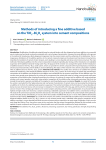
Статья научная
Introduction. Modification of traditional materials based on mineral binders with fine-dispersed and nano-additives is an essential way to create new functional construction materials with a set of unique characteristics. However, the main difficulty in this process is the method of introducing a finely dispersed component into the cement matrix and the uniformity of its distribution. The homogeneous distribution of the additive particles in the cement composite improves the physical and mechanical characteristics, intensifies the hydration of cement clinker minerals, and is leading to a more durable and dense cement stone structure. The main methods of introducing additives into the cement composition include joint grinding, dry mixing and the introduction of a stabilized suspension of the additive instead of mixing water. Thus, the purpose of this research is to compare the options for the introduction of additives based on the TiO2–Bi2O3 oxide system, which can provide the cement composite with improved physical, mechanical and structural characteristics and the ability to resist mold fouling. The object of this research is the cement compositions modified with an additive based on the TiO2–Bi2O3 system. Materials and methods. The studies were carried out to establish the optimal method of introducing a fine-dispersed additive based on the TiO2–Bi2O3 system. At the first stage, the phase and granulometric composition of the additive was studied, then the additive was introduced into the cement composition in four different ways. The cement stone samples were obtained by dry mixing of the components then mixed with water, by mixing cement powder with water suspension of the additive after ultrasound processing, by mixing a dry mixture of cement and an additive with water-plasticizer solution, and cement powder mixed with water-polymer suspension of the additive after ultrasound processing. After that, the strength characteristics, porosity and ability of the samples to resist fungi fouling were investigated. Results. As a result of the study, the authors concluded that the highest physical and mechanical characteristics of cement stone can be provided by introducing an additive in the form of a stabilized water-polymer suspension. This method contributes to the formation of a more durable and dense structure of cement stone, with an increase in strength of 31; 38 and 44.8% at first day age, 28; 30 and 32% at third day age and 2.4; 9.0 and 14% at 28 days age relative to the control sample containing cement, water and plasticizer. It was found that the highest strength results were shown by a sample containing a stabilized suspension of an additive with a concentration of 50 g/l. The study of the cement stone porosity showed its decrease by 13% at first day age in relation to the control sample with a plasticizer, and by 10% after 28 days of hardening. It was also shown that samples modified with 50 g/l (1.7 wt.%) of the additive demonstrate resistance to bio-fouling. Conclusion. As a result of the research, the authors concluded that the optimal way to introduce a finely dispersed additive based on the TiO2–Bi2O3 system is to mix cement powder with a stabilized water-polymer suspension of the additive, resulting in a more durable and dense structure of cement stone, especially at an early stage of hydration, which can also resist fungi bio-fouling. Thus, the authors came to the conclusion that the cement compositions obtained by this method can be applied as repair compounds and tile grout in damp shaded rooms with favorable conditions for fungi colonization.
Бесплатно
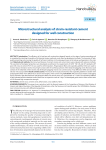
Microstructural analysis of strain-resistant cement designed for well construction
Статья научная
Introduction. The efficiency of oil and gas well construction depends largely on the stage of casing cementing and is completed by checking the quality of its fixing by various methods, most often by geophysical methods. The necessity of highquality cementing and ensuring the quality of technical conditions in the subsequent years of oil and gas well operation is the main task. Materials and methods. Microstructural features of cement slurries and cement stone were analyzed with advance methods. The essential technological properties were developed according to the requirements of GOST 1581-96 and API standards (API spec.10B). Class G cement (PCT-I-G) was used for all formulations. Polypropylene fiber and expanding additive СMA were used to increase impact resistance and to ensure tight contact with the confining surfaces of the obtained plugging stone. Microstructural analysis of the obtained cement stones and developed plugging mortars was carried out by X-ray diffraction (XRD) and scanning electron microscope (SEM). Results and discussion. The results of the study showed that the expanding additive in tandem with polypropylene fiber works effectively to ensure the integrity of the cement ring. Conclusion. Microstructural analysis of plugging stones showed a tight bond between polypropylene fiber and cement stone at a concentration of – 0.25%. The expanding additive is fully hydrated and the obtained cement stone has no expansion cracks at 7 days. The developed grouts with a water-cement ratio of 0.44 showed high compressive strength.
Бесплатно
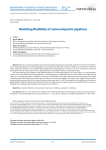
Modeling flexibility of nanocomposite pipelines
Статья научная
Pipes for oil and gas pipelines made of nanocomposite materials are increasingly used. The most common manufacture of composite piping is by winding fiberglass onto a rotating mandrel. With continuous winding, it is possible to choose the angle of laying the threads – the so-called angle of reinforcement. Depending on its value, as well as on the angle of curvature of the pipeline when its axis deviates from the straight direction, the strength indicators of the pipe change. The article discusses the modeling of the flexibility behavior of a composite pipeline of a curved shape. It is curved pipelines that are in the most difficult operating conditions, accompanied by the manifestation of the Karman effect in the pipe turning angles. As a modeling parameter, a coefficient of increase in the flexibility of the pipe is adopted. Influencing factors are the angle of reinforcement of the composite and the angle of curvature of the axis of the pipeline. An analysis of the results of the calculation performed earlier showed that in the range of reinforcement angles from 0о to 85о the dynamics of the coefficient of increase in pipe flexibility is different. Mathematical models have been developed for two ranges of values for the coefficient of increase in the flexibility of a composite pipe. Modeling error averages no more than 2%.
Бесплатно
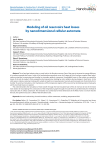
Modeling of oil reservoirs heat losses by nanodimensional cellular automata
Статья научная
The oil and gas industry plays a crucial role in the Russian economy. One of the ways to increase its energy efficiency is to reduce unproductive losses. Losses of oil and petroleum products occur at all stages of the oil and gas complex from hydrocarbon extraction to processing and transfer to secondary product consumers. Unavoidable losses in the system are caused by losses of oil and oil products from evaporation during excessive heating by solar radiation during storage in tank farms. In the cold season, intensive external cooling with outside air leads to increased product viscosity and increased cost of electricity for its transfer. To avoid such situations, strict maintenance of the temperature regime of the reservoir by minimizing external heat gains and its own heat losses is re-quired. The article describes the simulation of heat transfer through the heat-insulated wall of the oil reservoir of one of the linear main station of oil pumping. The construction of the temperature graph through the outer fence is performed by the method of nanoscale cells of cellular automaton. The simulation was carried out for three dimensions of the field of cells. It is shown that for the task, the optimal structure is a field of 560 simulation cells.
Бесплатно
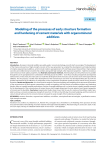
Статья научная
Introduction. At present, chemical modifiers are widely used in concrete technology, most of which are complex. The development of the theory and practice of high-strength concrete of the new generation has entailed the development and implementation of complex organomineral additives, which include modern superplasticizers (SP) and finely ground mineral fillers. High-strength concretes are multifunctional concretes that combine, along with high strength, other important properties – high frost resistance, water resistance, elastic-plastic properties, etc. Materials and research methods. Achieving high concrete performance is possible through the use of superplasticizers in combination with finely ground microfillers – stone flour, including nanoparticles and dispersed reinforcement. In this article, the main task is to model the development of the microstructure of cement stone with organomineral additives. For this purpose, a model of the development of the microstructure over time was developed taking into account the possible mechanisms of the influence of components on the composition of hydration products and the nature of early structure formation. Results and discussion. It is shown that the analysis of structural topology and modeling of the processes of formation of the microstructure of filled cement compositions, carried out together with the analysis of hydration products and hardening kinetics, allow us to predict possible mechanisms of action of complex additives and, in a certain sense, to predict possible scenarios for the development of the microstructure of cement stone, which largely determines the main physical and chemical properties of concrete and its durability. Conclusion. Experimental studies have shown that the use of a mixture of microfillers made it possible to achieve a concrete compressive strength of more than 115 MPa on the 28th day of normal hardening, and the insertion of calcium silicate hydrous into the concrete mixture increased the early strength of the hardening composite.
Бесплатно
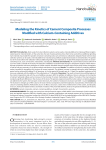
Modeling the Kinetics of Cement Composite Processes Modified with Calcium-Containing Additives
Статья научная
Introduction. Rock wastes from dust collection systems can be used as mineral additives for making artificial conglomerates based on mineral binders. At the same time, the size of waste particles allows them to be used without additional grinding. Such materials may include fine powders of calcium-containing rocks such as limestone, wollastonite, diopside. Waste rock from dust collection systems can be used as mineral additives for manufacturing artificial conglomerates based on mineral binders. The particle size of the waste allows their utilization without additional grinding. Such materials can include finely dispersed powders of calciumcontaining rocks, such as limestone, wollastonite, and diopside. Methods and materials. We used Portland cement CEM II/A-W 32.5F was used as a binder in the study. The selection of additives was determined through a comparative analysis of their thermodynamic properties with those analogous to clinker minerals. Standard research methods were used to study cement composites, as well as mercury porometry, X-ray phase analysis and electron microscopy. Results. The addition of calcium-containing additives makes it possible to strengthen the structure of cement materials. The greatest increase in strength during the initial hardening period can be achieved by adding 2% of limestone. In the late period of strength gain (in 14 days), the greatest hardening of the stone was obtained with the addition of 9% wollastonite or 7% diopside. Discussion. The results of cement stone diffractogram of the control composition and with the use of additives are given. With the addition of additives, there is a decrease in the intensity of calcium hydroxide reflexes and an increase in the intensity of calcium hydrosilicates reflexes. The study of the macrostructure revealed a significant difference in the structure of the stone. The porosity analysis showed that when calcium-containing additives are added into the system, the total pore volume decreases, the number of small pores increases (size 0.003–1.2 μm). Conclusion. The increase in strength up to 48% is due to the close chemical composition and thermodynamic characteristics of the binder and calcium-containing additives. Wollastonite, due to its fibrous structure, creates micro-reinforcement of the system, and diopside, in its turn, having the highest hardness and elastic modulus of the presented additives, leads to the greatest hardening of the stone.
Бесплатно
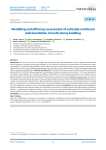
Статья научная
Introduction. The aim of this study is to investigate the structural behavior and effectiveness of slab foundations reinforced with vertical elements, a technique increasingly employed in civil engineering to improve the performance of foundations on weak, compressible soil. Traditional slab foundations often suffer from excessive settlement and low bearing capacity, especially under high loads from multi-storey buildings. Reinforcement of the soil base provides a viable solution to these challenges by improving stiffness and reducing deformation. Methods and Materials. The study is based on numerical modeling using the finite element method (FEM) in PLAXIS 3D software, applying the Hardening Soil model in accordance with Eurocode 7. A 9-storey building with a monolithic slab foundation was modeled, and different configurations of vertical reinforcing elements were analyzed. The key parameters varied in the simulations included the spacing (2×2 m, 3×3 m, and 5×5 m) and length (2.5 m, 5.5 m, and 9.5 m) of reinforcing elements. Soil properties were derived from site-specific geotechnical investigations. Results and Discussion. The analysis showed that reinforcing the slab foundation significantly reduced deformation (by a factor of three) and bending moments (by up to 60%) compared to the unreinforced case. The most efficient configuration was found to be concrete elements of 9.5 m length with 2×2 m spacing. The use of vertical reinforcement not only increased the bearing capacity of the foundation but also optimized the stress distribution within the soil mass, minimizing differential settlement. Conclusion. Vertically reinforced slab foundations provide a reliable and cost-effective solution for construction on weak soils. The study confirms that optimal design of reinforcing elements – particularly their length and spacing – plays a crucial role in improving foundation performance. These findings can be directly applied to enhance the design and safety of multi-storey building foundations under challenging geotechnical conditions.
Бесплатно
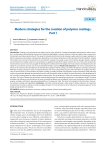
Modern strategies for the creation of polymer coatings. Part I
Статья научная
Introduction. Coatings on hard materials are widely used in many industries. Coating technologies help prevent or reduce corrosion, contamination and biofouling, chemical and structural degradation, and wear and tear of external surfaces due to exposure to the elements and natural environments. The range of materials used for functional coatings is quite wide: from organic polymers to hybrid composites and inorganic nanoparticles, depending on the desired properties and functionality of the final product. Despite the excellent anti-corrosion characteristics of non-polymer coatings, their usage causes environmental damage. Organic coatings are among the most widely used. Such compositions are applied in liquid form; organic solvents are one of the main components. Environmental concerns have encouraged the development of alternative technologies. The main areas for development are availability of raw materials and the cost of environmentally friendly coatings. Results and discussion. The review substantiates the relevance of research on the development of multifunctional polymer-based coatings. The market for polymer coatings is presented. Methods of surface protection, types of coatings formed, their main components, features of the formation of coatings, the influence of various factors on the formation of polymer coatings, including methods of preparation and pre-treatment of the protected surface are presented. Methods for preventing corrosion are discussed in detail, as well as the main directions in the development of anti-corrosion coatings based on various protective mechanisms. The characteristics of the main components of protective coatings are given. The issue of destruction of polymer coatings depending on the operating environment is considered in detail. The types of media, their influence and mechanisms of action on protected objects are considered. Factors and mechanisms of destruction of polymer coatings, methods for preventing degradation of coatings are listed. The latest technologies for the formation of protective polymer coatings are highlighted. Conclusion. Currently, coatings provide a wide range of quality indicators. An important characteristic of modern coatings is minimal negative impact on the environment, which requires an integrated approach to the design and production of coatings.
Бесплатно

